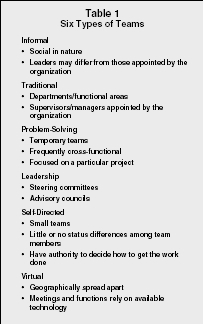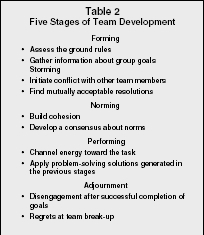TEAMS AND TEAMWORK

A team is a collection of individuals organized to accomplish a common purpose, who are interdependent, and who can be identified by themselves and observers as a team. Teams exist within a larger organization and interact with other teams and with the organization. Teams are one way for organizations to gather input from members, and to provide organization members with a sense of involvement in the pursuit of organizational goals. Further, teams allow organizations flexibility in assigning members to projects and allow for cross-functional groups to be formed.
TYPES OF TEAMS
There are six major types of teams: informal, traditional, problem solving, leadership, self-directed, and virtual. Table 1 describes some of the characteristics of these six types of teams.
INFORMAL TEAMS.
Informal teams are generally formed for social purposes. They can help to facilitate employee pursuits of common concerns, such as improving work conditions. More frequently however, these teams form out of a set of common concerns and interests, which may or may not be the same as the organization's. Leaders of these teams generally emerge from the membership and are not appointed by anyone in the organization.
TRADITIONAL TEAMS.
Traditional teams are the organizational groups commonly thought of as departments or functional areas. Leaders or managers of these teams are appointed by the organization and have legitimate power in the team. The team is expected to produce a product, deliver a service, or perform a function that the organization has assigned.

Six Types of Teams
| Informal |
|
| Traditional |
|
| Problem-Solving |
|
| Leadership |
|
| Self-Directed |
|
| Virtual |
|
PROBLEM SOLVING TEAMS.
Problem-solving teams or task forces are formed when a problem arises that cannot be solved within the standard organizational structure. These teams are generally cross-functional; that is, the membership comes from different areas of the organization, and are charged with finding a solution to the problem.
LEADERSHIP TEAMS.
Leadership teams are generally composed of management brought together to span the boundaries between different functions in the organization. In order for a product to be delivered to market, the heads of finance, production, and marketing must interact and come up with a common strategy for the product. At top management levels, teams are used in developing goals and a strategic direction for the firm as a whole.
SELF-DIRECTED TEAMS.
Self-directed teams are given autonomy over deciding how a job will be done. These teams are provided with a goal by the organization, and then determine how to achieve that goal. Frequently there is no assigned manager or leader and very few, if any, status differences among the team members.
These teams are commonly allowed to choose new team members, decide on work assignments, and may be given responsibility for evaluating team members. They must meet quality standards and interact with both buyers and suppliers, but otherwise have great freedom in determining what the team does. Teams form around a particular project and a leader emerges for that project. The team is responsible for carrying out the project, for recruiting team members, and for evaluating them.
VIRTUAL TEAMS.
Technology is impacting how teams meet and function. Collaborative software and conferencing systems have improved the ability for employees to meet, conduct business, share documents, and make decisions without ever being in the same location. While the basic dynamics of other types of teams may still be relevant, the dynamics and management of virtual teams can be very different. Issues can arise with a lack of facial or auditory clues; participants must be taken at their word, even when video-conferencing tools are used.
Accountability is impacted by taking a team virtual. Each member is accountable for their tasks and to the team as a whole usually with minimal supervision. Key factors in the success of a virtual team are effective formation of the team, trust and collaboration between members, and excellent communication.
CHARACTERISTICS OF EFFECTIVE TEAMS
Some characteristics of effective teams are clear direction and responsibilities, knowledgeable members, reasonable operating procedures, good interpersonal relationships, shared success and failures, and good external relationships.
CLEAR DIRECTION.
Clear direction means that the team is given a clear and distinct goal. The team may be empowered to determine how to achieve that goal, but management, when forming the team, generally sets the goal. A clear direction also means that team outcomes are measurable.
CLEAR RESPONSIBILITIES.
Clear responsibilities means that each team member understands what is expected of her or him within the team. The roles must be clear and interesting to the team members. Each team member needs to be able to rely on all the other members to carry out their roles so that the team can function effectively. Otherwise, one or two team members come to feel that they are doing all the work. This is one of the reasons so many individuals are initially reluctant to join teams.
KNOWLEDGEABLE MEMBERS.
An effective team will be comprised of individuals who have the skills and knowledge necessary to complete the team's task. Cooperation is essential at an early stage in inventorying the skills and knowledge each member brings to the team, and working to determine how to utilize those skills to accomplish the team task.
REASONABLE OPERATING PROCEDURES.
All teams need a set of rules by which they operate. Sports teams for example, operate according to a clearly laid-out set of rules about how the game is played. Similarly, work teams need a set of procedures to guide meetings, decision making, planning, division of tasks, and progress evaluation. Setting, and sticking to, procedures helps team members become comfortable relying on one another.
INTERPERSONAL RELATIONSHIPS.
Teams are composed of diverse individuals, each of whom comes to the team with his or her own set of values. Understanding and celebrating this diversity helps to make a stronger, more effective team.
SHARING SUCCESS AND FAILURES.
Everyone wants to feel appreciated. Within a team, members should be willing to express their appreciation, as well their criticisms, of others' efforts. Similarly, the organization must be willing to reward the team for successful completion of a task and hold all members responsible for failure.
EXTERNAL RELATIONSHIPS.
In the process of building a strong team, groups external to the team are frequently ignored. In order for the team to successfully complete its task, it cannot operate in isolation from the rest of the organization. Teams need help from people within the organization who control important resources. Establishing clear lines of communication with these people early on will facilitate the completion of the team's task.
TEAM BUILDING
The most successful teams go through five stages of development. Table 2 outlines these stages.

Five Stages of Team Development
| Forming |
|
| Storming |
|
| Norming |
|
| Performing |
|
| Adjournment |
|
FORMING.
Forming is the stage when team members become acquainted with one another. They also assess the group task and the ground rules that will apply to that task. At this stage everyone is typically very polite and willing to go along with suggestions made by other team members. Team members try to avoid making enemies and are frequently more patient with one another than they might be later in the process.
STORMING.
As the novelty of being a member of the team wears off, conflict emerges. Members of the team emerge who want to exert greater influence over the process. Leadership struggles begin, as do interpersonal conflicts. Conflicts erupt over the task requirements and the best way to achieve that task. This is the stage at which listening and finding mutually acceptable resolutions to the conflict is most important. The team can either emerge united and ready to take on the assigned task, or divided, with some members taking a passive role.
NORMING.
In the norming stage team members make an effort to discover what standards of performance are acceptable. What do deadlines really mean? How high a level of quality is necessary? Does every member have to be at every meeting? What about developing sub-teams? If the team can establish harmonious relationships at this stage, they are ready to move on to the performing stage. Some teams, however, disband at this stage.
PERFORMING.
At this stage the team is ready to be productive and work on the task assigned. Team members' roles have been established and clarified. Group interaction should be relatively smooth as the team applies some of the problem-solving skills it learned in earlier stages to the task at hand. If the team has reached this stage without successfully working through the problems and issues of the earlier stages, it may disband or regress and work through those issues.
ADJOURNMENT.
At some point almost all teams are disbanded, whether their task is completed or a team member leaves. On the one hand this can be a happy stage, with members congratulating one another on a job well done. On the other hand adjournment means the disruption of working arrangements that may have become comfortable and efficient, and possibly the end of friendships.
SELECTING THE TEAM MEMBERS
Forming an effective team is more complex than simply throwing a group of people together, assigning them a task, and hoping for the best. Potential team members need to be interviewed and their skills and knowledge should be assessed. Issues to consider in selecting team members include: the individual's motivation with respect to both the team and the task at hand; the attitudes and goals of potential team members; potential problems with intragroup relationships; and potential problems with relationships with external groups.
The organization needs to first assess what the skills, knowledge, and attitudes of potential team members should be. What are the tasks that need to be accomplished for the team to be successful? Have managers analyzed the jobs and developed an inventory of required skills and knowledge?
Once these steps have been completed, potential team members can be interviewed. Among the issues the interview process should cover are:
- What strengths does the individual bring to the team?
- What is she or he is willing to work on improving?
- What problem solving style does the individual employ?
- Can she or he share information in an effective manner?
- Does the individual have good listening skills?
- Can the individual provide constructive feedback?
It is important to remember that effective teams are generally made up of a variety of personalities. The selection process needs to be structured so that it is not biased toward one personality type. An effective team needs both the thoughtful, detail-oriented individuals, as well as the outgoing, insightful individuals.
Additional considerations for building an effective team are being identified. There are four important factors to consider when selecting team members:
- years of professional work experience;
- frequency of team participation;
- type of team training;
- situational entry to team assignments (volunteered, assigned, requested).
These factors can be effectively utilized by management when selecting team members to increase the opportunity for overall success.
ORGANIZATIONAL BENEFITS OF TEAMS
The major impetus for organizations to embrace the team concept is the effort to improve productivity and quality. Teams are a key component of many total quality management programs. The QS 9000 program, which suppliers to the major automobile manufacturers have embraced, relies on the team approach to ensure quality while maintaining a low-cost approach to manufacturing.
In addition to improved productivity and quality, some of an organization's major benefits from the use of teams are improved quality of work life for employees, reduced absenteeism and turnover, increased innovation, and improved organizational adaptability and flexibility. Effective implementation of teams can also improve office politics by improving the communication and trust between the team members.
IMPROVED QUALITY OF WORK LIFE.
Effective teams frequently improve the quality of work life for the employees. An effective team is generally one in which members are empowered to make decisions about how to get work done. Giving team members authority and control over the work processes reduces the amount of external control and increases the sense of ownership and accountability for the work being done. This helps to create a satisfying and rewarding work environment.
LOWER ABSENTEEISM AND TURNOVER.
A satisfying and rewarding work environment helps to lower absenteeism and turnover. Teams are particularly effective in this area. Membership in a work team gives an employee a sense of belonging, interaction with others on a regular basis, and recognition of achievements. All of these help to eliminate a sense of isolation within the organization. Team members identify with and feel pride in the work they are doing and come to rely on one another being there. At some companies, employees are evaluated based on their contribution to their team's efforts.
INCREASED INNOVATION.
W.L. Gore & Associates is an excellent example of a firm that utilizes the team concept and has a strong record of innovation. Gore is a multinational company structured around the concept of small plants (no more than 250 employees) where everyone works in teams. Everyone is allowed to experiment with the products and develop new uses. The result is that Gore has a continuous stream of patent applications and has been successful in developing new products in areas as diverse as clothing, surgical supplies, and coatings for industrial use.
ORGANIZATIONAL ADAPTATION AND FLEXIBILITY.
During the 1980s Ford was able to reduce its automobile design cycle by implementing Team Taurus. Through the early involvement of employees from planning, designing, engineering, and manufacturing, the company was able to eliminate some of the bottlenecks that had delayed the design process. The involvement of suppliers and assembly workers helped to decrease the number of parts involved and lower costs. Reducing the time from design to manufacture helped Ford to be more responsive to market changes and increase its market share in the 1980s and '90s.
Teams are not appropriate for all organizations or in all types of businesses. Behavioral scientists are still working to determine exactly when teams will be most effective, what motivates team members, what types of business can best benefit from the implementation of teams, and so on. The study of the philosophy and psychology of teamwork is still in its infancy. While effective teams can produce extraordinary results, studies have found that an estimated 50 percent of self-directed work teams culminate in failure.
The introduction of effective and stable new technologies has greatly affected teams and teamwork. Collaborative software and other multimedia options are providing businesses with tools to conduct teamwork regardless of location or time. New issues of accountability, team structure, and team selection are arising for management to deal with and coordinate within the businesses overall goals and objectives.
But as more and more businesses introduce the team concept, the wrinkles in the process are being ironed out and team popularity is growing. An increasing number of organizations are using teams to improve productivity and quality, and to solve a range of managerial problems.
Improved quality of work life and a reduction in absenteeism and turnover all contribute to a positive impact on the bottom line. Involving employees in teams helps the organization remain open to change and new ideas. As long as teams are seen as a means of improving the organization's ability to meet competitive challenges, teams will be part of the business world.
SEE ALSO: Empowerment ; Group Dynamics ; Participative Management
Stephanie Newell
Revised by Hal P. Kirkwood , Jr.
FURTHER READING:
Carney, Steven H. The Teamwork Chronicles: A Startling Look Inside the Workplace for Those Who Want Better Teamwork. Austin, TX: Greenleaf Book Group, LLC, 2003.
Gold, N. Teamwork: An Interdisciplinary Approach. New York, NY: Palgrave Macmillan, 2005.
Huszczo, Gregory E. Tools for Team Excellence: Getting Your Team into High Gear and Keeping It There. Palo Alto, CA: Davies-Black Publishing, 1996.
Johnson, P., V. Heimann, and K. O'Neill. "The 'Wonderland' of Virtual Teams." Journal of Workplace Learning 13, no. 1 (2001): 24.
"Managing Virtual Teams is Fraught with Difficulty, Says New Report." Training Journal 5 (May 2003).
Maxwell, John C. The 17 Indisputable Laws of Teamwork: Embrace Them and Empower Your Team. Nashville, TN: Nelson Books, 2001.
Nemiro, Jill. Creativity in Virtual Teams: Key Components for Success. San Francisco, CA: Pfeiffer, 2004.
Stewart, Greg L., Charles C. Manz, and Henry P. Sims. Team Work and Group Dynamics. New York, NY: John Wiley & Sons, 2000.
Weiss, W.H. "Team Management." SuperVision 65 no. 11 (November 2004): 19–21.
Each of us thinks differently to the other and sometimes we think that "our opinion" prevails over that of your partner, but how can we strike a balance? Is that right there is the key to success, how to develop us in a group of people whose skills, ways of thinking and willingness to work, sometimes differ from ours.
The team member must produce to get better results, focus on the processes to achieve goals, integrate with their peers, to be creative in problem solving, be tolerant of others, taking into account their colleagues and accept their differences, avoid those discussions that split the group and be efficient rather than effective.
work teams fail because:
-There is a pleasant working climate
-Plans are incorrectly
-There negativity and selfishness in the group
Members are discouraged and are not persistent
Those involved do not feel part of the group
He does not trust each other
i think we and the companies, need different disciplines to complement the knowledge and create better things?